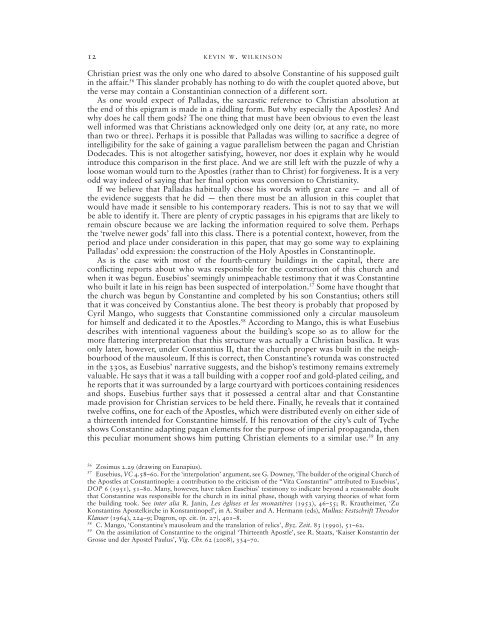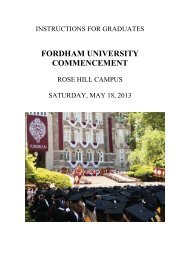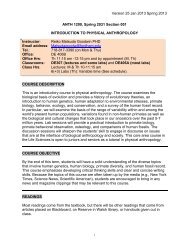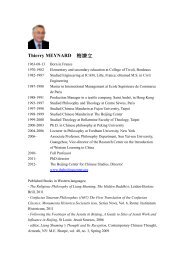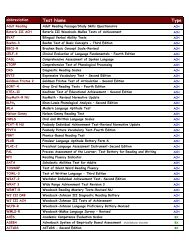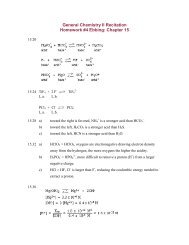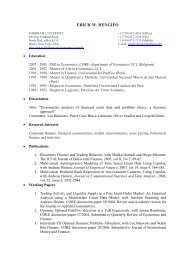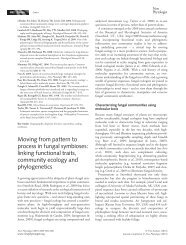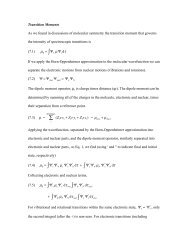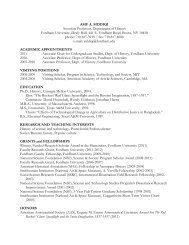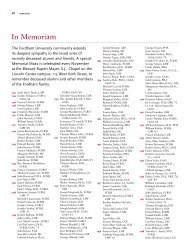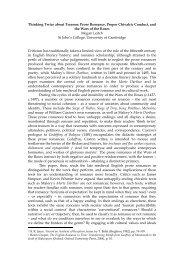Palladas and the Foundation of Constantinople - Fordham University
Palladas and the Foundation of Constantinople - Fordham University
Palladas and the Foundation of Constantinople - Fordham University
You also want an ePaper? Increase the reach of your titles
YUMPU automatically turns print PDFs into web optimized ePapers that Google loves.
12 K E V I N W. WILKINSON<br />
Christian priest was <strong>the</strong> only one who dared to absolve Constantine <strong>of</strong> his supposed guilt<br />
in <strong>the</strong> affair. 56 This sl<strong>and</strong>er probably has nothing to do with <strong>the</strong> couplet quoted above, but<br />
<strong>the</strong> verse may contain a Constantinian connection <strong>of</strong> a different sort.<br />
As one would expect <strong>of</strong> <strong>Palladas</strong>, <strong>the</strong> sarcastic reference to Christian absolution at<br />
<strong>the</strong> end <strong>of</strong> this epigram is made in a riddling form. But why especially <strong>the</strong> Apostles? And<br />
why does he call <strong>the</strong>m gods? The one thing that must have been obvious to even <strong>the</strong> least<br />
well informed was that Christians acknowledged only one deity (or, at any rate, no more<br />
than two or three). Perhaps it is possible that <strong>Palladas</strong> was willing to sacrifi ce a degree <strong>of</strong><br />
intelligibility for <strong>the</strong> sake <strong>of</strong> gaining a vague parallelism between <strong>the</strong> pagan <strong>and</strong> Christian<br />
Dodecades. This is not altoge<strong>the</strong>r satisfying, however, nor does it explain why he would<br />
introduce this comparison in <strong>the</strong> fi rst place. And we are still left with <strong>the</strong> puzzle <strong>of</strong> why a<br />
loose woman would turn to <strong>the</strong> Apostles (ra<strong>the</strong>r than to Christ) for forgiveness. It is a very<br />
odd way indeed <strong>of</strong> saying that her fi nal option was conversion to Christianity.<br />
If we believe that <strong>Palladas</strong> habitually chose his words with great care — <strong>and</strong> all <strong>of</strong><br />
<strong>the</strong> evidence suggests that he did — <strong>the</strong>n <strong>the</strong>re must be an allusion in this couplet that<br />
would have made it sensible to his contemporary readers. This is not to say that we will<br />
be able to identify it. There are plenty <strong>of</strong> cryptic passages in his epigrams that are likely to<br />
remain obscure because we are lacking <strong>the</strong> information required to solve <strong>the</strong>m. Perhaps<br />
<strong>the</strong> ‘twelve newer gods’ fall into this class. There is a potential context, however, from <strong>the</strong><br />
period <strong>and</strong> place under consideration in this paper, that may go some way to explaining<br />
<strong>Palladas</strong>’ odd expression: <strong>the</strong> construction <strong>of</strong> <strong>the</strong> Holy Apostles in <strong>Constantinople</strong>.<br />
As is <strong>the</strong> case with most <strong>of</strong> <strong>the</strong> fourth-century buildings in <strong>the</strong> capital, <strong>the</strong>re are<br />
confl icting reports about who was responsible for <strong>the</strong> construction <strong>of</strong> this church <strong>and</strong><br />
when it was begun. Eusebius’ seemingly unimpeachable testimony that it was Constantine<br />
who built it late in his reign has been suspected <strong>of</strong> interpolation. 57 Some have thought that<br />
<strong>the</strong> church was begun by Constantine <strong>and</strong> completed by his son Constantius; o<strong>the</strong>rs still<br />
that it was conceived by Constantius alone. The best <strong>the</strong>ory is probably that proposed by<br />
Cyril Mango, who suggests that Constantine commissioned only a circular mausoleum<br />
for himself <strong>and</strong> dedicated it to <strong>the</strong> Apostles. 58 According to Mango, this is what Eusebius<br />
describes with intentional vagueness about <strong>the</strong> building’s scope so as to allow for <strong>the</strong><br />
more fl attering interpretation that this structure was actually a Christian basilica. It was<br />
only later, however, under Constantius II, that <strong>the</strong> church proper was built in <strong>the</strong> neighbourhood<br />
<strong>of</strong> <strong>the</strong> mausoleum. If this is correct, <strong>the</strong>n Constantine’s rotunda was constructed<br />
in <strong>the</strong> 330s, as Eusebius’ narrative suggests, <strong>and</strong> <strong>the</strong> bishop’s testimony remains extremely<br />
valuable. He says that it was a tall building with a copper ro<strong>of</strong> <strong>and</strong> gold-plated ceiling, <strong>and</strong><br />
he reports that it was surrounded by a large courtyard with porticoes containing residences<br />
<strong>and</strong> shops. Eusebius fur<strong>the</strong>r says that it possessed a central altar <strong>and</strong> that Constantine<br />
made provision for Christian services to be held <strong>the</strong>re. Finally, he reveals that it contained<br />
twelve c<strong>of</strong>fi ns, one for each <strong>of</strong> <strong>the</strong> Apostles, which were distributed evenly on ei<strong>the</strong>r side <strong>of</strong><br />
a thirteenth intended for Constantine himself. If his renovation <strong>of</strong> <strong>the</strong> city’s cult <strong>of</strong> Tyche<br />
shows Constantine adapting pagan elements for <strong>the</strong> purpose <strong>of</strong> imperial propag<strong>and</strong>a, <strong>the</strong>n<br />
this peculiar monument shows him putting Christian elements to a similar use. 59 In any<br />
56 Zosimus 2.29 (drawing on Eunapius).<br />
57 Eusebius, VC 4.58–60. For <strong>the</strong> ‘interpolation’ argument, see G. Downey, ‘The builder <strong>of</strong> <strong>the</strong> original Church <strong>of</strong><br />
<strong>the</strong> Apostles at <strong>Constantinople</strong>: a contribution to <strong>the</strong> criticism <strong>of</strong> <strong>the</strong> “Vita Constantini” attributed to Eusebius’,<br />
DOP 6 (1951), 51–80. Many, however, have taken Eusebius’ testimony to indicate beyond a reasonable doubt<br />
that Constantine was responsible for <strong>the</strong> church in its initial phase, though with varying <strong>the</strong>ories <strong>of</strong> what form<br />
<strong>the</strong> building took. See inter alia R. Janin, Les églises et les monastères (1953), 46–55; R. Krau<strong>the</strong>imer, ‘Zu<br />
Konstantins Apostelkirche in Konstantinopel’, in A. Stuiber <strong>and</strong> A. Hermann (eds), Mullus: Festschrift Theodor<br />
Klauser (1964), 224–9; Dagron, op. cit. (n. 27), 401–8.<br />
58 C. Mango, ‘Constantine’s mausoleum <strong>and</strong> <strong>the</strong> translation <strong>of</strong> relics’, Byz. Zeit. 83 (1990), 51–62.<br />
59 On <strong>the</strong> assimilation <strong>of</strong> Constantine to <strong>the</strong> original ‘Thirteenth Apostle’, see R. Staats, ‘Kaiser Konstantin der<br />
Grosse und der Apostel Paulus’, Vig. Chr. 62 (2008), 334–70.


